杭州师范大学(2010-2017)考研真题
- 格式:pdf
- 大小:614.70 KB
- 文档页数:8
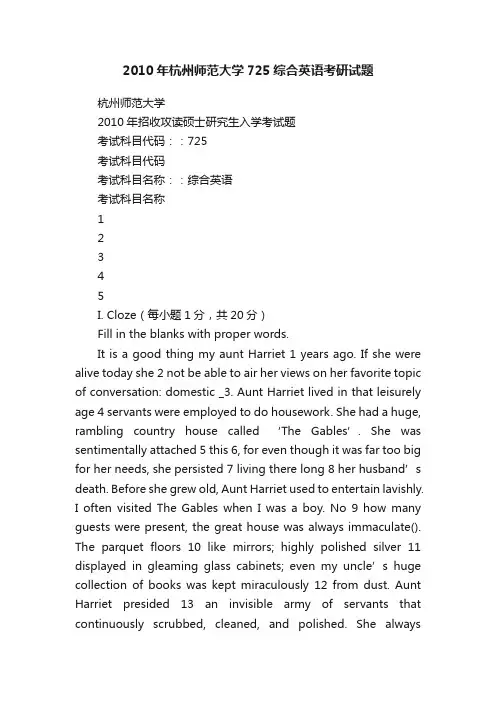
2010年杭州师范大学725综合英语考研试题杭州师范大学2010年招收攻读硕士研究生入学考试题考试科目代码::725考试科目代码考试科目名称::综合英语考试科目名称12345I. Cloze(每小题1分,共20分)Fill in the blanks with proper words.It is a good thing my aunt Harriet 1 years ago. If she were alive today she 2 not be able to air her views on her favorite topic of conversation: domestic _3. Aunt Harriet lived in that leisurely age 4 servants were employed to do housework. She had a huge, rambling country house ca lled ‘The Gables’. She was sentimentally attached 5 this 6, for even though it was far too big for her needs, she persisted 7 living there long 8 her husband’s death. Before she grew old, Aunt Harriet used to entertain lavishly.I often visited The Gables when I was a boy. No 9 how many guests were present, the great house was always immaculate(). The parquet floors 10 like mirrors; highly polished silver 11 displayed in gleaming glass cabinets; even my uncle’s huge collection of books was kept miraculously 12 from dust. Aunt Harriet presided 13 an invisible army of servants that continuously scrubbed, cleaned, and polished. She alwaysreferred to them 14 ‘the shifting population’, for they came and 15 with 16 frequency that I never even got a chance to 17 their names. Though my aunt pursued 18 was, in those days, an enlightened policy, in 19 she never allowed her domestic staff to 20 more than eight hours a day, she was extremely difficult to please.II. Reading Comprehension(每小题2分,共40分)Part ARead the following three texts. Answer the questions on each text by choosing A, B, Cor D.Text AIn recent years, linguists and language teachers have begun to describe language according not only to grammatical structure, using traditional concepts and terms such as the imperative, but also by function, that is, the use to which language is put. For example, add ‘please’ to the order ‘Open the window!’, and the structure remains imperative. The function of the utterance, however, is now that of request, and polite request at that. Function, then, is determined partly by the user’s attitude, and is realized by a variety of linguistic and paralinguistic features—vocabulary, grammar and pronunciation, tone of voice, gesture and facial expression. The language learner can often distinguish passively between certain basic functions—those of command and request, for example—although learning to use these different functions of language to communicate effectively is not always so easy.Function is also determined by the situation in which the language is used. ‘Be quiet!’ coming from a teacher tired of noisy pupils is obviously an order, or command. Used by onenervous bank robber to a fellow in crime, when he thinks he has heard a noise which could have been made by a suspicious policeman, the sentence would be a warning. Used again, as they prepare to blow open the safe, its function would be that of cautioning; too loud an explosion would give them away. Look at ‘the imperative’ in this way, then, and we realize that it consists of a small set of structural forms which can fulfill many different functions: command, prohibition, warning, persuasion, as well as many others.To sum up, the approach to the study and use of language through the examination of its functions has been enriching for teachers and learners alike. For both, of course, the functional approach does not do without the need for attention to be paid to the workings of the grammar of a language, but it is an approach which extends the uses to which the control of structure may be put.1. According to the text, language function is controlled by ________.[A] linguists and language teachers[B] linguistic and paralinguistic features[C] the speaker and listener[D] the user’s attitude a nd situation2. Adding ‘please’ to the utterance ‘Open the window’ does not change ________.[A] language function[B] grammatical structure[C] linguistic features[D] paralinguistic features3. The examples given in paragraph 2 illustrate the point that ________.[A] teachers are good at language functions but pupils are not[B] the same utterance can be used to express different meanings[C] the utterance ‘Be quiet’ is no longer an imperative sentence[D] bank robbers are skillful in using language functions4. Which of the following statements is true according to the text?[A] Language function is a traditional concept.[B] The functional approach has made language teachers wealthy.[C] Language function is not used in effective communication.[D] The knowledge of grammar cannot be replaced by language function.5. The text implies that language learners ________.[A] can learn how to use language functions easily in communication[B] can do better in examinations if they are taught language functions[C] will benefit from functional approach in language learning[D] will learn grammar better when they use language functionsText BFootball is not a new thing in Japan. In 1873 a British delegation advising Japan on how to build up its naval forces also organized the first game of football ever played there. The Japanese followed the British naval instructions well, scoringimpressive away victories in the Russo-Japanese War, but the football lessons were less successful. Baseball, introduced by American missionaries around the same time, became Japan’s national game. Football remained a minor sport until the late 1980s, when advertising executives identified it as a useful vehicle for reaching young consumers, many of whom find baseball too slow-moving. B ut by the late 90s Japan’s inconsistent young consumers began to move on to new crazes, like caring for robotic pet dogs. Some clubs went bankrupt and, despite the triumph of hosting the World Cup, football was once again a minor sport.Could anyone take the game as played in Japan seriously? For one thing, the Japanese call it socca, a language corruption of the sport’s name among Americans, who, of course, know next to nothing about the game. For another, Japanese crowds are polite. Painfully so. They hold up signs urging PLEASE SHOW US YOUR BEST PERFORMANCE. They shout ol é(which comes out or é) in response to impressive plays, while a samba band bangs away. At half-time fans line up to buy snacks. After games, smiling fans struggle eagerly to catch furry toys tossed into the crowd by the players --- once they have completed their postgame bowing ceremonies.On the pitch, Japanese players, their hair dyed bright colors to attract the attention of the thousands of young women who crowd the stands, display a discouraging lack of competitiveness. Is it really possible that a nation would produce football stars who are submissive and risk-shy? Yes, say the many European and South American coaches and players drawn to Japan by generous salaries. They struggle to explain this oddity. Perhaps, they suggest, the Japanese are not a people who are culturallyencouraged to express their individuality forcefully. As a result, the Japanese game often lacks the style and strength of South American and European football.6. What was the main purpose of a British delegation in Japan?[A] assist the Japanese in building warships[B] instruct the Japanese in increasing the size of its navy[C] help the Japanese to organize its first football game[D] train the Japanese for their first football match with the Russians7. We can infer from the passage that ________.[A] football became popular after Japan succeeded in its bid for the World Cup[B] baseball was introduced to Japan to replace football as a national game[C] baseball was popular because elderly Japanese found it slow-moving[D] football has been a national game in Japan for about a decade8. According to the writer, the term socca is a clue to ________.[A] why Japanese football is not to be taken seriously[B] why the Japanese do not attach importance to football[C] what Japanese and American football has in common[D] what the Japanese and the Americans are ignorant of9. The passage suggests that Japanese football is not as good as South American and European football in that ________.[A] foreign players enjoy higher salaries[B] foreign coaches do not work hard enough[C] Japanese players are brought up in a different culture[D] Japanese players are keen on attracting young women’s attention10. The writer’s attitude towards Japanese fans’ behavior can best be described as ________.[A] understanding[B] approving[C] appreciative[D] amusedText CWhenever I see anyone buying a National Lottery ticket I want to stop them and ask if they know just where their money is going.The lottery money is supposed to go to charity—but it makes me angry to see some of the so-called “good causes” it’s being used to support. Also, Camelot, the organizers, have made a profit of £10.8 million in five months. We hear now that a lot of that money is boosting the pay packets of the company’s bosses.For the past 10 years I’ve been helping to raise funds for a cancer research charity called T enovus. My husband, Sandy, died from cancer 11 years ago—he was only 51. There’s been a lo ng line of deaths in our family through cancer and it’s been devastating. I’ve also lost two sisters-in-law, my brother, Michael, my father-in-law and my father. That’s apart from several close friends.The charity is 50 years old now and raises money mainly for breast cancer research. It also runs a support line for the families of cancer sufferers. Our local group raises money through dances, sales and coffee mornings, and all the funds go directly to cancer research. In 1993 Tenovus raised £3 million—and half that money came from sales of our own lottery tickets at supermarkets. But our income has dropped by half since theNational Lottery was introduced.I’m not against people playing the National Lottery, but they should think about what they’re doing. The chances of winning the jackpot are so small; they might as well throw their money away. The Government tells us that the proceeds are going to things like the arts and sport, but what about the National Health Service? They should give some cash to that, too. How can they justify spending ridiculous amounts of cash on so-called works of art—like displays of potatoes—or buying up Winston Churchill’s papers at a cost of £12 million?So who really are the winners in the National Lottery? When I think of all that money people could be donating to cancer research, I could weep. It’s time people realized how charities across the country are suffering because of the National Lottery. It’s disheartening and so infuriating.11. The writer seems to hope that ________.[A] people will spend more money on the National Lottery[B] people will give more money to charity[C] most of the lottery money will go to charity[D] most of the lottery money will be used for cancer research12. The reason why the writer raises funds for cancer research is that ________.[A] she herself is suffering from cancer[B] the cancer is the most frightening disease[C] a number of her relatives died of cancer[D] some cancer research needs more money than other research13. In this text the writer is expressing ________.[A] her personal opinions[B] the opinions of the general public[C] her feelings about cancer sufferers[D] some ideas of fund-raising14. The organization “T enovus” is ________.[A] run by a group of people in the writer’s town[B] a charity organization which has some local groups[C] set up to collect money for people who lose their relatives[D] set up to assist the National Lottery15. From the text we can conclude that ________.[A] the writer is enthusiastically supporting the National Lottery[B] the writer has objections to the National Lottery[C] the writer believes that the lottery money should be used for cancer research[D] the writer is just expressing her feelings about collecting money for charityPart BRead the texts about five cities in Scotland. For questions 16 to 20, match the name of the city to one of the statements (A to G given below)ABER1FOYLE is the dramatically-set southern gateway to the beautiful Trossachs. The Scottish Wool Centre celebrates Scotland’s shepherding traditions with an entertaining and informative live show. Handspinners and weavers invite you to turn wool into cloth in the old-fashioned way, and on a sunny day there’s nothing more relaxing than to take a walk on the walkway beside the River Forth.ALEXANDRIA is near Loch Lomond. In 1904, it became the site for the Argyll Motor Works. John Logic Baird, television pioneer, learned his skills here. In May 1997 the factory becamethe home of the Classic Car Collection, a new museum of Scottish motoring memories appealing to the whole family: sit in an Edwardian car or climb aboard a 1920s lorry, there’s plenty to see. Valuable exhibits and a videowall bring the ‘collection to life.COATBRIDGE lies to the east of Glasgow. Most of the woolen sweaters produced here are famous names in Scotland—including The Edinburgh Woolen Mill—which are made here at Mackinnon Mills on Kirkshaws Road. From the manufacturing exhibition (view the complicated processes of high quality production) to a range of shops, the visitor center proudly proclaims “there is something to suit everyone, and all under one roof? You can also find the Mackinnon Mills Factory Outlet Shop which is attractive to bargain hunters.EDINBURGH is Scotland’s capital and, unti l the union with England in 1707, the site of its parliament. A short journey from the Royal Mile brings you to Leith, the seaport where Queen Mary landed on returning from France in 1561. At James Pringle Weavers, Leith Mills on Bangor Road, a well-produced exhibition tells the stirring history of tartan, a checked woolen cloth for which Scotland is famous.NEW LANARK was founded around 1785. The site exploited a natural energy source, the Falls of Clyde. Soon, mills employing 1,500 people had been built, together with houses for the workforce. Robert Owen developed the plan successfully and is still remembered as. an important social reformer. New Lanark has won major awards for heritage conservation and for the exceptional attractions. Pick up a bargain i n Owen’s Warehouse—Edinburgh Woolen Mill’s largest store in Scotland.Note: there are two extra statements.Statements16. ABERFOYLE [A] The tourist will see successful examples of old buildings17. ALEXANDRIA which have been protected.18. COATBRIDGE [B] The tourist will see how woolen garments are made.19. EDINBURGH [C] The tourist will see a roofless building of the Middle Ages.20. NEW LANARK [D] The tourist will see how sheep are tended and learn to weave.[E] The tourist will learn the history of the typical Scottish garmentmaterial.[F] The tourist will see how Scots make their famous alcoholicdrink.[G]The tourist will learn the history of Scotland’s automobileindustry.III. Translation(每小题20分,共40分)A. Translate the following passage from Chinese into English. (20%)B. Translate the following passage from English into Chinese. (20%)Although facts, as we said, are no argument and can even be disputed, it is easy to prove that present conditions are dangerous for the industrial arts, decidedly fatal for the traditional higher arts. The abundance of means is the first great danger with which art has to struggle. This expression is illogical, I admit (there is no abundance of means but only an inability to master them); however, it is justified in that it correctly describesthe inverted state of our conditions.IV. Paraphrase the following underlined parts or the whole sentences.(共20分)1. We often speak of language as a vehicle of expression--- a metaphor that can illumine many aspects of our foreign-language teaching situation. Language is a vehicle of meaning that we do not even realize we are using; in other words, a vehicle that is transporting a person’s message somewhere but is not itself the object of the trip2.The literary fashion of these days is not to know what you mean and to shrug a careless shoulder and say that you write what you write and the reader must make his own interpretation. The author’s observations are presumed to be pregnant; the reader is to be midwife and bring the child to birth. It is no business of genius to make itself plain.3. Most domestic beasts seem machines almost pure and simple, unhesitatingly doing from minute to minute the duties they have been taught, and giving no sign that the possibility of an alternative ever suggests itself to their mind.4. After the failure of his last novel his reputation stands on slippery grounds.5. United, there is little we cannot do in a host of co-operative ventures. Divided, there is little we can do.6. It is often said that, provided we are not of the unfortunate minority of people who have pathological( pathological: caused by or connected with disease) language defects, our language mechanism automatically equips us to say anything we need to say. What it means is that if my job or hobby entailed a knowledge of some activities, my language would rise to the occasion of talking about these activities.7. The social tensions of the times often foster a societyespecially prone to depression.V. Writing(共30分)Please write in at least 400 words a commentary essay based on the topic: What Role Does Linguistics Play in Language Learning? Pay attention to the focus of your theme, development of ideas, origination of structures and choice of dictions.。

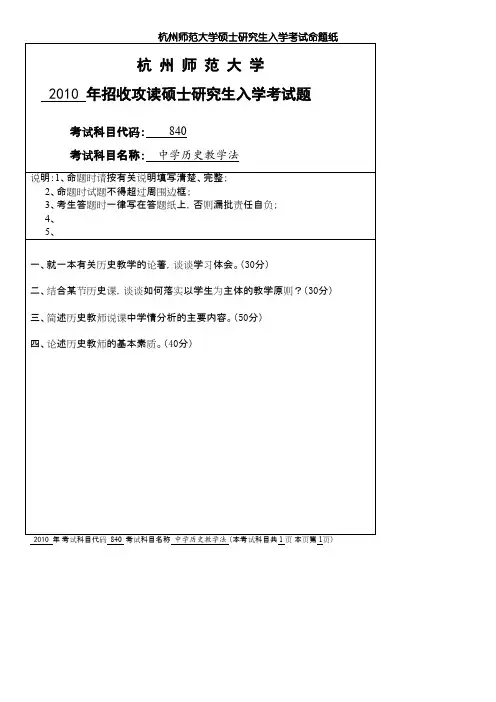
杭州师范大学硕士研究生入学考试命题纸
杭州师范大学
2010年招收攻读硕士研究生入学考试题
考试科目代码:840
考试科目名称:中学历史教学法
说明:1、命题时请按有关说明填写清楚、完整;
2、命题时试题不得超过周围边框;
3、考生答题时一律写在答题纸上,否则漏批责任自负;
4、
5、
一、就一本有关历史教学的论著,谈谈学习体会。
(30分)
二、结合某节历史课,谈谈如何落实以学生为主体的教学原则?(30分)
三、简述历史教师说课中学情分析的主要内容。
(50分)
四、论述历史教师的基本素质。
(40分)
2010年考试科目代码 840 考试科目名称中学历史教学法(本考试科目共 1 页本页第 1页)。
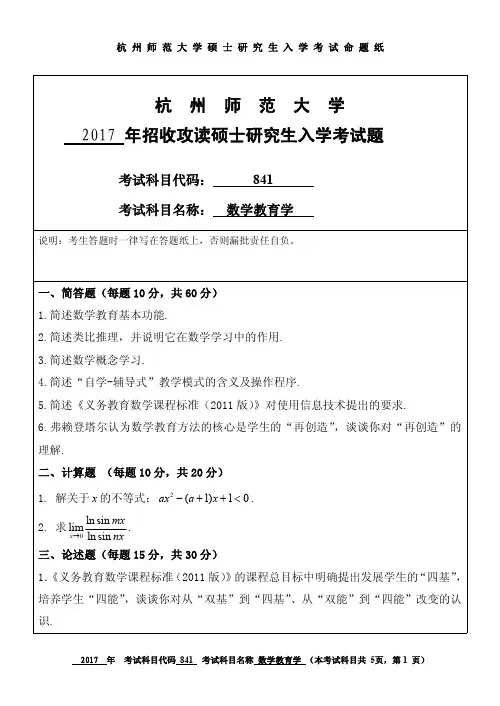
杭州师范大学
2017年招收攻读硕士研究生入学考试题
考试科目代码:841
考试科目名称:数学教育学
说明:考生答题时一律写在答题纸上,否则漏批责任自负。
一、简答题(每题10分,共60分)
1.简述数学教育基本功能.
2.简述类比推理,并说明它在数学学习中的作用.
3.简述数学概念学习.
4.简述“自学-辅导式”教学模式的含义及操作程序.
5.简述《义务教育数学课程标准(2011版)》对使用信息技术提出的要求.
6.弗赖登塔尔认为数学教育方法的核心是学生的“再创造”,谈谈你对“再创造”的理解.
二、计算题(每题10分,共20分)
1.解关于x 的不等式:2(1)10ax a x -++<.
2.求0ln sin lim ln sin x mx nx
→.三、论述题(每题15分,共30分)
1.《义务教育数学课程标准(2011版)》的课程总目标中明确提出发展学生的“四基”,培养学生“四能”,谈谈你对从“双基”到“四基”、从“双能”到“四能”改变的认识.
2.“函数”是中学数学的核心概念,谈谈你对初中、高中“函数”概念的理解.
四、案例设计(共40分)
附件是初中“不等式的基本性质”的教材内容。
请依据该内容设计一个详细的教案。
要求包括以下内容:学情分析,教材分析,教学目标,重点、难点,教学方法,教学过程(反映出教学指导思想和师生的活动情况).(不低于1000字)。

杭州师范大学硕士研究生入学考试命题纸杭州师范大学2010年招收攻读硕士研究生入学考试题考试科目代码: 244考试科目名称:二外英语说明:1、命题时请按有关说明填写清楚、完整;2、命题时试题不得超过周围边框;3、考生答题时一律写在答题纸上,否则漏批责任自负;4、严格按照要求答题。
要求选择相应字母的,写词不得分;要求单选的,多选不得分。
5、要求书写字迹清楚,模糊不清不得分。
Part I Reading Comprehension (Skimming and Scanning) (15 minutes) Directions: In this part, you will have 15 minutes to go over the passage quickly and answer the questions on Answer Sheet 1. For questions 1 -- 7, choose thebest answer from the four choices marked A) , B), C)and D). Forquestions 8--10, complete the sentences with the information given in thepassage.(20points)When Your Child Hates SchoolWith just a few minutes left before school was to start, my six-year-old, Dustin, was unhappy. "I don't want to go," he said. Ever since he'd entered first grade, he hated school. What's going on? I thought as he trudged(沉重吃力地走) out the door. If he hates school this much now, how bad will it be later on?Every kid occasionally grumbles about school. But five to ten percent of kids dislike it so much that they don't want to attend, says Christopher Kearney, director of the Child School Refusal and Anxiety Disorders Clinic at the University of Nevada, Las Vegas.If a child seems depressed or anxious about school, fakesillness to stay home, repeatedly winds up in the nurse's orprincipal's office, or refuses to talk about large chunks of the school day, you should be concerned, say school psychologists Michael Martin and Cynthia Waltman Greenwood, co-editors of Solve Your Child's School-Related Problems.Fortunately, you can usually solve the problem--sometimes very easily. In our case,my husband and I visited Dustin's class and noticed that the teacher, fresh2010年考试科目代码 244 考试科目名称二外英语(本考试科目共 12 页本页第 1 页)。
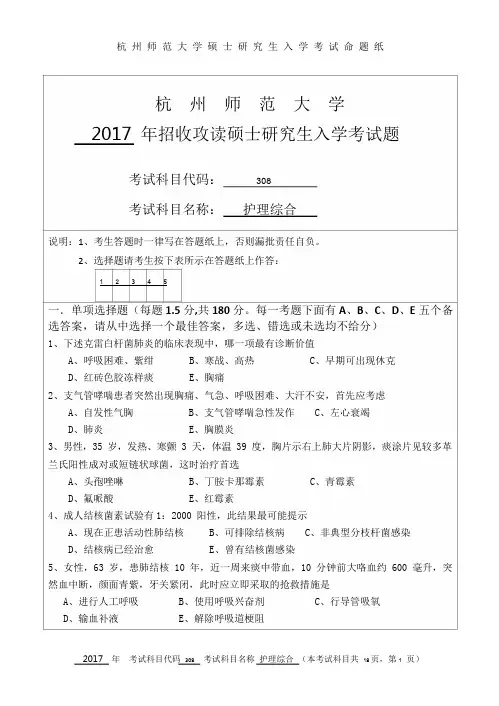
杭州师范大学硕士研究生入学考试命题纸杭州师范大学2017年招收攻读硕士研究生入学考试题考试科目代码:308考试科目名称:护理综合说明:1、考生答题时一律写在答题纸上,否则漏批责任自负。
2、选择题请考生按下表所示在答题纸上作答:12345一.单项选择题(每题1.5分,共180分。
每一考题下面有A、B、C、D、E五个备选答案,请从中选择一个最佳答案,多选、错选或未选均不给分)1、下述克雷白杆菌肺炎的临床表现中,哪一项最有诊断价值A、呼吸困难、紫绀B、寒战、高热C、早期可出现休克D、红砖色胶冻样痰E、胸痛2、支气管哮喘患者突然出现胸痛、气急、呼吸困难、大汗不安,首先应考虑A、自发性气胸B、支气管哮喘急性发作C、左心衰竭D、肺炎E、胸膜炎3、男性,35岁,发热、寒颤3天,体温39度,胸片示右上肺大片阴影,痰涂片见较多革兰氏阳性成对或短链状球菌,这时治疗首选A、头孢唑啉B、丁胺卡那霉素C、青霉素D、氟哌酸E、红霉素4、成人结核菌素试验有1:2000阳性,此结果最可能提示A、现在正患活动性肺结核B、可排除结核病C、非典型分枝杆菌感染D、结核病已经治愈E、曾有结核菌感染5、女性,63岁,患肺结核10年,近一周来痰中带血,10分钟前大咯血约600毫升,突然血中断,颜面青紫,牙关紧闭,此时应立即采取的抢救措施是A、进行人工呼吸B、使用呼吸兴奋剂C、行导管吸氧D、输血补液E、解除呼吸道梗阻杭州师范大学硕士研究生入学考试命题纸6、早期二氧化碳蓄积,血压、脉搏的变化应该是A、血压下降,脉搏减慢B、血压上升,脉搏增快C、血压不变,脉搏减慢D、血压上升,脉搏减慢E、血压下降、脉搏增快7、肺气肿患者的胸廓呈A、鸡胸B、扁平胸C、桶状胸D、漏斗胸E、一侧局限性膨隆8、25岁,女,心悸、气促、反复咯血,体检:心尖部可闻舒张期隆隆样杂音,P2亢进,双肺可闻湿性罗音,最可能的诊断为A、风心病、二尖瓣狭窄并左心衰竭B、急性心肌梗塞C、急性病毒性心肌炎D、支气管扩张E、肺梗塞9、患者男性36岁,乏力、晕厥史三天,心电图P波与QRS波无关系,P波频率90次每分,QRS波32次每分,首选哪种治疗方法A、含化硝酸甘油B、立即同步电复律C、静脉注射西地兰D、静脉注射心得安E、安装临时起搏器10、风心病二尖瓣狭窄病人最常见并发症是A、脑栓塞B、阵发性心动过速C、亚急性感染性心内膜炎D、心房颤动E、过早搏动11、给急性肺水肿患者吸氧,氧流量最好为A、1-2L/minB、2-3L/minC、3-4L/minD、4-6L/minE、6-8L/min12、急性下壁心肌梗塞最易合并A、肺水肿B、心源性休克C、室上性快速性心律失常D、室壁瘤E、房室传导阻滞13、男性、65岁,有高血压病史20余年,平时不间断服用降压药物,1小时前突然出现明显头痛,烦燥心悸,多汗,恶心,呕吐、视物模糊、面色潮红,BP为260/130mmHg,本病例的治疗首先考虑选用A、利尿剂口服B、限制钠摄入C、硝普钠静滴D、β受体阻滞剂E、复方降压片14、左心功能不全最早期的体征为A、舒张早期奔马律B、肺水泡音C、颈静脉搏动D、肝肿大E、下肢浮肿15、关于老年人高血压正确的认识A、不易发生心力衰竭B、血压波动性较大C、以舒张压增高为主D、不易发生体位性低血压D、患病率不随年龄增长而增加16、慢性充血性心力衰竭的诱发因素最常见的是A、严重的心律失常B、妊娠与分娩C、过度的情绪激动D、各种感染E、输液过快过量17、男性、72岁,发热、咳嗽4天,病后进食少,既往经常心悸、胸闷,求诊于当地保健院,诊断为肺部感染,给予抗感染、补液等治疗,10小时后突然发生心悸、咳嗽加重,气急,被迫坐起,最大可能由于A、发热B、肺部感染加重C、输液反应D、输液不足E、急性肺水肿18、引起亚急性感染性心内膜炎最常见的致病菌为A、金黄色葡萄球菌B、肠球菌C、革兰氏阳性细菌D、厌氧菌E、草绿色链球菌19、为预防急性胰腺炎的发生应重点注意哪项A、吸烟B、少食脂肪C、戒酒及避免暴饮暴食D、餐后剧烈运动E、精神紧张20、男性、55岁,上腹痛10年,餐后痛,服药有效,近三个月来,腹痛变为无规律,食欲减退,查体:轻贫血貌,上腹压痛,未扪及包块,多次粪便隐血,应考虑下述哪一项诊断最合适A、胃溃疡活动期B、胃溃疡并慢性穿孔C、胃溃疡并胃炎D、胃溃疡恶性变E、胃溃疡并出血21、患者因消化道出血住院三天,今晨起感头昏,心慌、查血压80/60mmHg,脉搏118次每分,血尿素氮12.4mmol/L,最可能的原因是A、肾功能不全B、电解质紊乱C、酸中毒D、继续出血E、低血糖22、男性患者70岁,因偏瘫昏迷就诊,诊断为脑溢血,患者随后出现呕血、黑便,最可能的病因是A、胃溃疡B、十二指肠球部溃疡C、胃癌D、肝硬化食管胃底静脉曲张破裂出血E、急性糜烂性胃炎23、上消化道出血部位是指A、食管、胃出血B、食管、胃、十二指肠球部出血C、屈氏韧带以上部位出血D、空肠以上部位出血E、回盲瓣以上部位出血24、一例大量呕血与黑粪的急诊患者,测血压80/60mmHg,P134次/分,出血不止,病因不明,当前的首要措施是A、补充血容量B、急诊胃镜检查C、急诊手术治疗D、立即输注止血药物E、立即三腔二囊管压迫止血25、胃体胃炎(A型胃炎)合并恶性贫血时可能检出A、抗线粒体抗体B、抗内因子抗体C、G细胞抗体D、抗核抗体E、抗平滑肌抗体26、肝性脑病,左旋多巴的作用机制是A、减少肠道氨气的形成和吸收B、降血氨C、纠正氨基酸代谢不平衡D、补充脑部正常神经递质E、防治脑水肿27、尿毒症时,下列哪项临床表现最主要是由于肾脏内分泌功能障碍所致A、氮质血症B、贫血C、代谢性酸中毒D、胃肠道症状E、心包摩擦音28、心血管疾病中,引起脑血管栓塞的原因,下列哪项最常见A、二尖瓣关闭不全B、二尖瓣狭窄C、主动脉瓣狭窄D、高血压、动脉硬化E、心力衰竭29、肾病综合症最重要的改变是A、高度浮肿B、高血压C、高脂血症D、大量蛋白尿E、低蛋白血症30、尿毒症患者必有的症状为A、少尿B、高血压C、恶心呕吐D、贫血E、气喘31、缺铁性贫血用铁剂治疗后判定有效的早期指标是A、自觉症状明显改善B、HB、RBC计数上升C、网织红细胞计数上升D、骨髓内外铁恢复正常E、血清铁、总铁结合力恢复正常32、人体对铁吸收率最高的部位是A、胃及十二指肠上端B、十二指肠及空肠上端C、回肠及升结肠上端D、空肠及回肠上段E、各结肠及横结肠上段33、急性淋巴细胞白血病患者,在诱导缓解治疗中,突发中枢神经系统症状主要原因是A、化疗药物用量不当B、化疗药物不能透过血脑屏障C、化疗药物的毒性作用D、免疫能力低下E、合并病毒感染34、抗甲状腺药物最常见的副作用是A、甲状腺机能低下B、皮肤过敏C、白细胞减少D、肝功能损害E、消化道症状杭州师范大学硕士研究生入学考试命题纸35、甲状腺功能亢进患者消化系统一般不出现的表现为A、易饥多食B、肝脏肿大C、体重锐减D营养不良E、便秘36、抢救糖尿病酮症酸中毒昏迷,患者静脉注射小剂量胰岛素治疗的用量最合适的是A、0.1单位/公斤/小时B、0.4单位/公斤/小时C、0.5单位/公斤/小时D、0.7单位/公斤/小时E、1.0单位/公斤/小时37、有关应用胰岛素的护理注意事项中,下列哪项不妥A、采用lml注射器B、使用时保存在室温20℃以下C、剂量必须准确D、正规胰岛素在早饭前lh注射E、注射部位应经常更换38、下列症状,哪项是甲状腺机能亢进性的特殊表现:A、胫前粘液水肿B、多食善饥C、心动过速D、神经过敏E、月经过少39、病人女性,17岁,学生,患1型糖尿病5年,一直使用胰岛素治疗,近日学校体能测试加大了运动量,病人出现了心悸、出汗、头晕、手抖饥饿感。
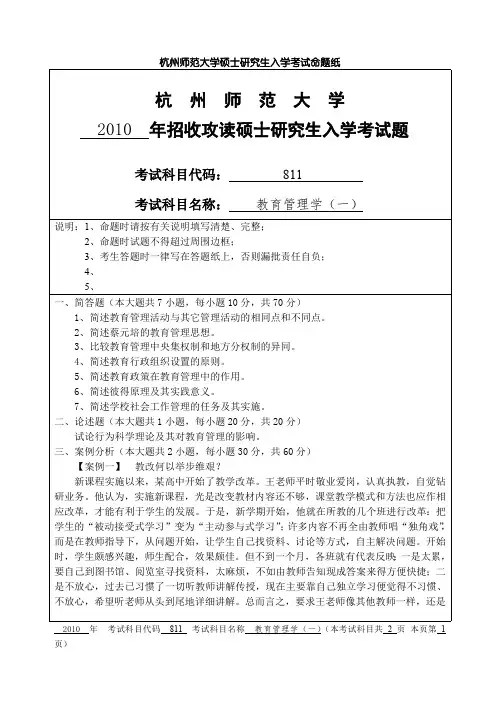
杭州师范大学硕士研究生入学考试命题纸杭州师范大学2010年招收攻读硕士研究生入学考试题考试科目代码:811考试科目名称:教育管理学(一)说明:1、命题时请按有关说明填写清楚、完整;2、命题时试题不得超过周围边框;3、考生答题时一律写在答题纸上,否则漏批责任自负;4、5、一、简答题(本大题共7小题,每小题10分,共70分)1、简述教育管理活动与其它管理活动的相同点和不同点。
2、简述蔡元培的教育管理思想。
3、比较教育管理中央集权制和地方分权制的异同。
4、简述教育行政组织设置的原则。
5、简述教育政策在教育管理中的作用。
6、简述彼得原理及其实践意义。
7、简述学校社会工作管理的任务及其实施。
二、论述题(本大题共1小题,每小题20分,共20分)试论行为科学理论及其对教育管理的影响。
三、案例分析(本大题共2小题,每小题30分,共60分)【案例一】教改何以举步维艰?新课程实施以来,某高中开始了教学改革。
王老师平时敬业爱岗,认真执教,自觉钻研业务。
他认为,实施新课程,光是改变教材内容还不够,课堂教学模式和方法也应作相应改革,才能有利于学生的发展。
于是,新学期开始,他就在所教的几个班进行改革:把学生的“被动接受式学习”变为“主动参与式学习”;许多内容不再全由教师唱“独角戏”,而是在教师指导下,从问题开始,让学生自己找资料、讨论等方式,自主解决问题。
开始时,学生颇感兴趣,师生配合,效果颇佳。
但不到一个月,各班就有代表反映:一是太累,要自己到图书馆、阅览室寻找资料,太麻烦,不如由教师告知现成答案来得方便快捷;二是不放心,过去已习惯了一切听教师讲解传授,现在主要靠自己独立学习便觉得不习惯、不放心,希望听老师从头到尾地详细讲解。
总而言之,要求王老师像其他教师一样,还是2010年考试科目代码811 考试科目名称教育管理学(一)(本考试科目共 2 页本页第1 页)杭州师范大学硕士研究生入学考试命题纸采用讲授法为好。
王老师虽又在各班作了几次“晓之以理,动之以情”的动员,但收效甚微。
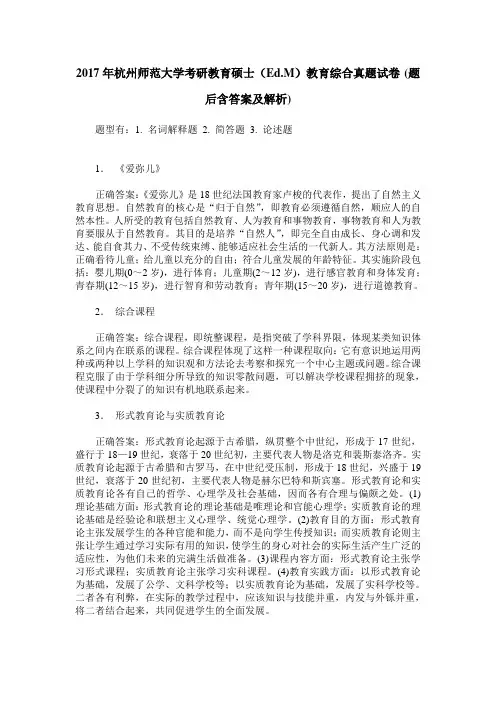
2017年杭州师范大学考研教育硕士(Ed.M)教育综合真题试卷(题后含答案及解析)题型有:1. 名词解释题 2. 简答题 3. 论述题1.《爱弥儿》正确答案:《爱弥儿》是18世纪法国教育家卢梭的代表作,提出了自然主义教育思想。
自然教育的核心是“归于自然”,即教育必须遵循自然,顺应人的自然本性。
人所受的教育包括自然教育、人为教育和事物教育,事物教育和人为教育要服从于自然教育。
其目的是培养“自然人”,即完全自由成长、身心调和发达、能自食其力、不受传统束缚、能够适应社会生活的一代新人。
其方法原则是:正确看待儿童;给儿童以充分的自由;符合儿童发展的年龄特征。
其实施阶段包括:婴儿期(0~2岁),进行体育;儿童期(2~12岁),进行感官教育和身体发育;青春期(12~15岁),进行智育和劳动教育;青年期(15~20岁),进行道德教育。
2.综合课程正确答案:综合课程,即统整课程,是指突破了学科界限,体现某类知识体系之间内在联系的课程。
综合课程体现了这样一种课程取向:它有意识地运用两种或两种以上学科的知识观和方法论去考察和探究一个中心主题或问题。
综合课程克服了由于学科细分所导致的知识零散问题,可以解决学校课程拥挤的现象,使课程中分裂了的知识有机地联系起来。
3.形式教育论与实质教育论正确答案:形式教育论起源于古希腊,纵贯整个中世纪,形成于17世纪,盛行于18—19世纪,衰落于20世纪初,主要代表人物是洛克和裴斯泰洛齐。
实质教育论起源于古希腊和古罗马,在中世纪受压制,形成于18世纪,兴盛于19世纪,衰落于20世纪初,主要代表人物是赫尔巴特和斯宾塞。
形式教育论和实质教育论各有自己的哲学、心理学及社会基础,因而各有合理与偏颇之处。
(1)理论基础方面:形式教育论的理论基础是唯理论和官能心理学;实质教育论的理论基础是经验论和联想主义心理学、统觉心理学。
(2)教育目的方面:形式教育论主张发展学生的各种官能和能力,而不是向学生传授知识;而实质教育论则主张让学生通过学习实际有用的知识,使学生的身心对社会的实际生活产生广泛的适应性,为他们未来的完满生活做准备。
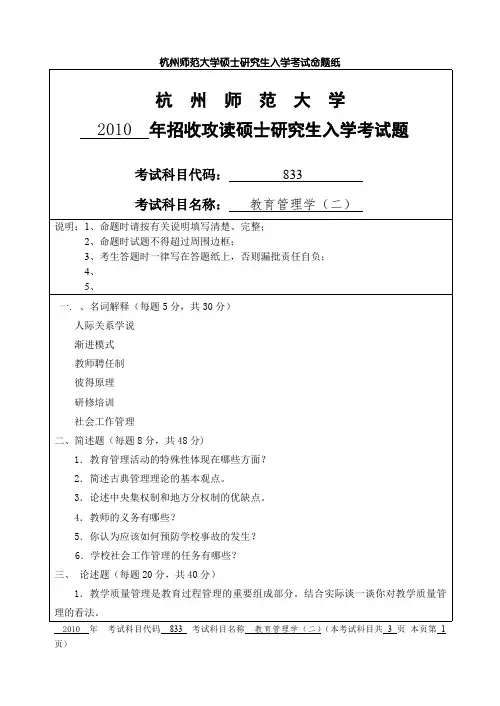
杭州师范大学硕士研究生入学考试命题纸杭州师范大学2010年招收攻读硕士研究生入学考试题考试科目代码:833考试科目名称:教育管理学(二)说明:1、命题时请按有关说明填写清楚、完整;2、命题时试题不得超过周围边框;3、考生答题时一律写在答题纸上,否则漏批责任自负;4、5、一. 、名词解释(每题5分,共30分)人际关系学说渐进模式教师聘任制彼得原理研修培训社会工作管理二、简述题(每题8分,共48分)1.教育管理活动的特殊性体现在哪些方面?2.简述古典管理理论的基本观点。
3.论述中央集权制和地方分权制的优缺点。
4.教师的义务有哪些?5.你认为应该如何预防学校事故的发生?6.学校社会工作管理的任务有哪些?三、论述题(每题20分,共40分)1.教学质量管理是教育过程管理的重要组成部分。
结合实际谈一谈你对教学质量管理的看法。
2010年考试科目代码833 考试科目名称教育管理学(二)(本考试科目共 3 页本页第1 页)杭州师范大学硕士研究生入学考试命题纸2.试用所学的教育管理理论分析“为什么在教育管理中坚持以人为本更为重要?”四、案例分析:(每题16分,共32分)1.该不该实行“末位淘汰制”?A校最近准备出台一项新政策,对教师考核工作实行“末位淘汰制”。
制度的出台主要是想进一步调动教师的教育教学积极性,在教师集体中形成良性的竞争氛围,促使大家提高效率,保证质量,力争上游,从而提高学校的整体升学率;如果任课教师所带班级学生的考试成绩不理想,就会被“下课”或“重新找岗位”。
消息一经传开,教师们议论纷纷。
张老师说:“实行末位淘汰制,对于拖家带口的众多老师无疑会带来一种压力。
这种压力可能会促进教师更努力地工作,却也会产生一些不好的结果。
听说,前不久就有一个学校的教师因为末位淘汰制而得了精神病。
”陈老师说:“一旦实行末位淘汰制,每个人都会害怕成为最后一个而‘下课’,这也将会破坏同事之间已经形成的良好关系,妨碍他们之间的合作。

杭州师范大学2010年招收攻读硕士研究生入学考试题考试科目代码::241考试科目代码考试科目名称::二外德语考试科目名称12345.15A .100.51. schnell2. der V orteil3. neu4. aus/packen5. ohne6. groß7. vermieten8.erfolglos9. sauber 10. schwarzB. (er/sie/es)100.51. laufen2. geben3. lesen4. fahren5. nehmen6. halten7. sehen8. tragen9. fallen 10. schlafenC. 100.51. beginnen2. essen3. helfen4. kommen5. gehen6. vergessen7. treffen8. tun9. rufen 10. finden.151. Ich habe heute keine Zeit, _________.a. ob ich ins Kino geheb. dass ich ins Theater zu gehenc. ins Konzert zu gehend. ich ins Theater gehe2. Unterwegs war ein Verkehrsstau. _________ bin ich etwas zu spät gekommen.a. Deshalbb. Weilc. Dennd. Warum3. Ich _______ gern eine Tasse Kaffee und ein Stück Kuchen.a. würdeb. hättec. könnted. wäre4. Er weiß nicht, ______sie Geburtstag hat?a. wieb. wannc. wod. woher5. Ich möchte in eine Stadt gehen, _______an einem Fluß liegt und _______Einwohner freundlich sind.a. der, dessenb. das, dessenc. die, derend. die, dessen6. Hans steht am Morgen _______spät auf, _______ er keine Zeit für das Frühstückhat.a. viel, dassb. so, dassc. so, obd. dass, so7. Ich freue mich darauf, meine Familie bald wieder ______ sehen.a. mitb. zuc. dassd. /8. ---Was für ein Film ist es?---Ich weiß auch nicht, was für _______ das ist.a. einenb. einec. einerd. ein9. Auf die Frage, ________ wir ihm helfen sollten, antwortete er mit 〝Nein〞.a. dassb. obc. wied. wobei10. Japan, _______ viele Studenten kommen, liegt in Asien.a. aus demb. woc. woherd. wohin11. Meine Uhr _________ nicht mehr.a. läuftb. gehtc. renntd. fährt12. Es ist noch nicht sicher, _______ ich mitfahren kann.a. obb.dassc. damitd. wenn13. ________ länger man sich mit der Forschung der Naturerscheinung befasst,_________ mehr Erkenntnisse gewinnt man.a. Wenn, dannb. Je, destoc. so, dassd. entweder, oder14. ---Wann geben Sie mir mein Geld wieder?---Morgen gebe ich _______ bestimmt zurück.a. es dieb. es siec. dir esd. es Ihnen15. Heute Abend gibt es ein Fußballspiel. Hast du Lust_____?a.dazub.damitc.darüberd.davonⅢ按要求填空。

杭州师范大学硕士研究生入学考试命题纸
杭州师范大学
2010年招收攻读硕士研究生入学考试题
考试科目代码:331
考试科目名称:体育综合
说明:1、命题时请按有关说明填写清楚、完整;
2、命题时试题不得超过周围边框;
3、考生答题时一律写在答题纸上,否则漏批责任自负;
4、
5、
第一部分《运动训练学》
、、单项选择题(命题的备选答案中有一个是正确的,请将所选的正确答案的字母写在题后括号内。
每小题2分,共20 分)
1、下列不属于竞技体育基本的构成要素是()
A 生物学因素
B 个性心理因素
C社会学因素 D美学因素
2、运动训练的最终目的是()
A 提高竞技能力
B 创造优异运动成绩
C提高健康水平 D学习运动技术
3、下列不属于运动员竞技能力表现形式的是( )
A 体能
B 技能
C 战术能力 D运动成绩
4、运动员所具备的竞技能力在比赛中的表现称为()
A 竞技状态
B 竞技水平
C 运动能力 D训练水平
5、一个完整训练过程的出发点是()
A 运动员的状态诊断
B 训练目标的建立
C 运动员选材 D运动竞赛
2010年考试科目代码 331 考试科目名称体育综合(本考试科目共 6 页本页第 1 页)
杭州师范大学硕士研究生入学考试命题纸。
杭州师范大学2017年招收攻读硕士研究生入学考试题考试科目代码:743考试科目名称:外国文学(一)说明:考生答题时一律写在答题纸上,否则漏批责任自负。
一、名词解释(每题8分,共40分)1、文艺复兴2、浮士德精神3、荒诞派戏剧4、川端康成5、《高老头》二、简答题(每题20分,共60分)1、希腊神话的特点和意义。
2、试以一个剧本为例,谈谈莎士比亚的艺术成就。
3. 俄罗斯文学中的“多余人”形象。
三、论述题(每题25分,共50分)1. 阅读文本,撰写不少于400字的分析文章,题目自拟。
没有走过的路[美] 罗伯特•弗罗斯特金黄的林中有两条岔路,可惜我作为一名过客,不能两条都走,我久久踌躇,极目遥望一条路的去处,直到它在灌木丛中隐没。
我走了第二条,它也不坏,而且说不定更加值得,因为它草多,缺少人踩;不过这点也难比较出来,两条路踩的程度相差不多。
那天早晨两条路是一样的,都撒满落叶,还没踩下足迹。
啊,我把第一条路留待来日!尽管我明白:路是连着路的,我怀疑是否还能重返旧地。
此后不论岁月流逝多少,我提起此事总要伴一声叹息:两条路在林中分了道,而我呢,我选了较少人走的一条,此后的一切都相差千里。
2. 阅读文本,撰写不少于400字的分析文章,题目自拟。
捡橡果的孩子[英] 理查德•杰弗里斯黑乌鸦,黄橡叶,树下睡着一个小男孩。
他把头枕在树干边凸起的根块上,脚伸向已装满一半橡果的小包或小袋。
酣睡间,他额头紧锁——展不开的皱纹像橡树皮上的裂痕。
除此之外,他的容貌既不讨人喜欢,也不令人生厌,是一群贫苦人家孩子中普普通通的一个。
紧蹙的怒眉是唯一不同于他人的特征——就像被防滑钉踩过留下凹痕的一枚硬币,凭这个印记才能把它从二十个完全相同的硬币中区分出来。
他的衣服不比麻布片好多少,但缝补洗刷得干净整洁。
谁都会说:“家境不好,但照料还挺仔细。
”有个好心人也许会在他紧捏的手中塞进三便士,然后发一声叹息。
但即使得了钱,他那幼嫩额头上铁箍般紧锁的双眉也不会舒展开来。
杭州师范大学2010年招收攻读硕士研究生入学考试题考试科目代码:332考试科目名称:教育综合说明:1、命题时请按有关说明填写清楚、完整;2、命题时试题不得超过周围边框;3、考生答题时一律写在答题纸上,否则漏批责任自负;4、5、一、名词解释题:(6小题,每小题5分,共30分)1、班级授课制2、学制3、教育目的4、学科课程5、德育6、高原现象二、简答题:(4小题,每小题10分,共40分)1、简述我国科举制度的主要特点及其对教育的影响2、简述文艺复兴时期人文主义教育的主要特征及其对教育的贡献3、简述启发教学原则的含义及其贯彻这一原则的基本要求4、简述马斯洛的需要层次理论三、分析论述题:(4小题,每小题 20分,共80分)1、试述陶行知的生活教育理论2、评述杜威的儿童中心论的主要观点3、结合实际,谈谈如何利用注意的规律组织课堂教学4、请联系实际谈谈在教师专业化要求的背景下,教师应具备怎样的职业素质?2010年考试科目代码332 考试科目名称教育综合(本考试科目共1 页本页第1 页)杭州师范大学2011年招收攻读硕士研究生入学考试题考试科目代码:333考试科目名称:教育综合说明:1、命题时请按有关说明填写清楚、完整;2、命题时试题不得超过周围边框;3、考生答题时一律写在答题纸上,否则漏批责任自负;一、名词解释(6小题,每小题5分,共30分)1、学校教育2、教育目的的社会本位论3、苏格拉底法4、贝尔—兰卡斯特制5、教学做合一6、《学记》二、简答题(4小题,每小题10分,共40分)1、简述教育的相对独立性。
2、影响问题解决的主要因素有哪些?3、简述书院教育的特点。
4、简要评述孔子的道德教育思想。
三、论述题(4小题,每小题20分,共80分)1、如何正确理解掌握知识与发展智力的关系?2、自古而来,对教师的角色有许多隐喻,如“教师是蜡烛,燃烧自己照亮别人”“教师是人类灵魂的工程师,塑造着学生的精神世界”等等。
请从“蜡烛论”和“工程师论”中任选一种教师角色的隐喻分析其蕴涵的意义。
杭州师范大学2017年招收攻读硕士研究生入学考试题考试科目代码: 353考试科目名称:卫生综合说明:考生答题时一律写在答题纸上,否则漏批责任自负。
一、单项选择题(每题2分,共220分)1. 构成职业性有害因素致病模式的三个因素是()A. 劳动者、职业性有害因素、作用条件B. 易感者、病原、作用途径C. 易感者、接触机会、接触强度D. 接触方式、劳动者、有害因素种类E. 以上都不是2. 生产过程中的职业性有害因素按性质可分为()A. 异常气象条件、噪声与震动、辐射线B. 化学性因素、物理性因素、生物性因素C. 生产过程性有害因素、劳动过程有害因素、劳动环境有害因素D. 细菌、病毒、霉菌毒素E. 劳动组织不合理、劳动强度过大、工具性因素3. 铅引起机体的主要早期变化之一是()A. 小血管痉挛B. 卟啉代谢障碍C. 对神经鞘细胞作用D. 大脑神经细胞变性E. δ氨基r-酮戊酸的分解增加4. 目前国内驱铅治疗的常用解毒剂是()A. 二巯基丙磺酸钠B. 亚硝酸钠-硫代硫酸钠C. 二巯基丁二酸D. 依地酸二钠钙E. 二巯基丙醇5. 可反映机体近期苯接触程度的指标是()A. 尿马尿酸B. 尿酚C. 尿甲基马尿酸D. 尿苯基硫迷氯酸E. 尿葡萄糖醛酸6. 水溶性小的刺激性气体是()A. SO2、Cl2B. 氮氧化物、光气C. 氮氧化物、SO2D. 甲醛、SO2、NO2E. 光气、Cl2、SO27. 热射病的主要发病机制为()A. 大量出汗导致血容量不足B. 机体脱水后补充大量淡水C. 机体蓄热导致中枢体温调节功能障碍D. 外周血管扩张致脑供血不足E. 头部受强热辐射直接照射致脑组织水肿8. 有关石棉肺病理改变,不正确的是()A. 以肺间质弥漫性胶原纤维增生为主要特征B. 胸膜受累较常见C. 组织切片或痰液中可检出其独有的含铁小体D. 病变后期大体肺切面可见灰白色纤维化索条和网架E. 胸膜斑的大小和数量与肺内纤维化病变可不一致9.某男,33岁,热水瓶厂喷漆工,近五年来常感头昏乏力,失眠,多梦,牙龈出血,皮下偶可见到紫癜,其可能与接触何种毒物有关()A. CS2B. CCl4C. 正已烷D. 二甲苯E. 苯10.某男性,磨床操作工,工龄15年,例行检查胸片可见不规则小阴影,调离原接尘岗位1年后复查,小阴影密度减低,数量减少,考虑该患者为()A. 尘肺B. 化学性肺炎C. 粉尘沉着症D. 变态反应性肺泡炎E. 以上都不是11. 自然环境的基本构成是()A. 物质环境和自然环境B. 物质环境和原生环境C. 非物质环境和社会环境D. 自然环境和生活环境E. 原生环境和次生环境12. 环境组成因素按其属性可分为()A. 化学因素、物理因素、放射性因素、社会因素B. 化学因素、生物因素、放射性因素、社会因素C. 化学因素、物理因素、生物因素、社会心理因素D. 有机污染物、无机污染物、放射性因素、社会心理因素E. 致癌物、致突变物、放射性因素、内分泌干扰物13. 次生环境是指()A. 受动物活动影响的天然环境B. 受人为活动影响的自然环境C. 未受人类活动影响的环境D. 以人类为中心的环境E. 以人类为中心的社会环境14. 下列属于二次污染物的是()A. 铅笔厂排放到大气中的铅尘B. 居民日常采暖向大气排放的烟尘C. 工业废水中排放的无机汞D. 工业燃料燃烧排放的SO2形成的酸雨E. 汽车运行时向大气中排放的碳氢化合物15. 生物地球化学疾病是()A. 自然疫源性疾病B. 种族遗传性疾病C. 区域内的传染病D. 地质环境因素导致的疾病E. 严重环境污染导致的公害病16. 大气污染对健康产生间接危害的是()A. 慢性中毒B. 变态反应C. 急性中毒D. 肺癌E. 全球气候变暖17. 不属于大气污染对健康危害的是()A. 呼吸道炎症B. 呼吸系统疾病死亡率升高C. 免疫功能下降D. 微量元素缺乏E. 肺癌18. 能形成酸雨的前体化学物是()A. PAHB. O2C. CH4D. SO2E. Fe19. 大量使用氯氟烃(CFCs)造成全球环境主要卫生问题是()A. 海洋温度上升,水生生物死亡B. 臭氧层破坏,皮肤癌、白内障等疾病发病率上升C. 生物多样性锐减,导致生态失调D. 呼吸系统的发病率上升E. 植被破坏,导致沙漠化20. 下列属于生物地球化学性疾病的是()A. 地方性甲状腺肿B. 痛痛病C. 布氏菌病D. 佝偻病E. 甲型肝炎21. 下列有关营养不良的描述,错误的是()A. 营养缺乏是营养不良的一种表现形式B. 中国居民面临宏量营养素缺乏和微量营养素过剩的双重挑战C. 营养素过量摄入对健康有危害作用D. 营养不良可表现为营养缺乏和营养过剩E. 肥胖是一种营养不良疾病22. 可以满足人群中50%个体对该营养素需要的指标是()A. 营养素参考摄入量B. 平均需要量C. 推荐摄入量D. 适宜摄入量E. 可耐受最高摄入量23. 含维生素D相对较少的食物是()。
2017年杭师大教育综合真题及答案(333)考试命题纟纸杭州师范大学2017年招收攻读硕士研究生入学考试题考试科目代码:333考试科目名称:教育综合说明:考生答题时一律写在答题纸上,否则漏批责任自负。
一、名词解释(6小题,每小题5分,共30分)1、班级授课制【答案】班级授课制是一种集体教学形式,它把一定数量的学生按年龄与知识程度编成固定的班级,根据周课表和作息时间表,安排教师有计划地向全班学生集体上课。
同一班级的学生学习内容和进度必须一致。
班级授课制的特点是学生固定、教师固定、时间固定、场所固定、内容固定。
班级授课制虽然不易照顾到学生2017年考试科目代码333考试科目名称教育综合(本考试科目共18页,第2页)考试命题纸2017年考试科目代码333考试科目名称教育综合(本考试科目共18页,第3页)2017年考试科目代码333考试科目名称教育综合(本考试科目共18页,第4页)2017年考试科目代码333考试科目名称教育综合(本考试科目共18页,第5页)杭州师范大学硕士研究生入学考试命题纸2017年考试科目代码333考试科目名称教育综合(本考试科目共18页,第6页)杭州师范大学硕士研究生入学考试命题纸2017年考试科目代码333考试科目名称教育综合(本考试科目共18页,第7页)杭州师范大学硕士研究生入学考试命题纸2017年考试科目代码333考试科目名称教育综合(本考试科目共18页,第8页)2017年考试科目代码333考试科目名称教育综合(本考试科目共18页,第9页)2017年考试科目代码333考试科目名称教育综合(本考试科目共18页,第10页)杭州师范大学硕士研究生入学考试命题纸2017年考试科目代码333考试科目名称教育综合(本考试科目共18页,第11页)杭州师范大学硕士研究生入学考试命题纸走上制度化发展的轨道。
其中体现了书院的精神,对当时及以后的书院教育,而且对官学教育都产生了重大影响,其贡献不可低估。
目 录2010年杭州师范大学842综合英语考研真题及详解2011年杭州师范大学723综合英语考研真题及详解2012年杭州师范大学716综合英语考研真题及详解2013年杭州师范大学718综合英语考研真题及详解2014年杭州师范大学718综合英语考研真题及详解2015年杭州师范大学718综合英语考研真题及详解2016年杭州师范大学724综合英语考研真题及详解2017年杭州师范大学723综合英语考研真题及详解2018年杭州师范大学723综合英语考研真题及详解2019年杭州师范大学718综合英语考研真题及详解2010年杭州师范大学842综合英语考研真题及详解Part Ⅰ. Cloze (20points)Directions: Read the following text. Choose the best word(s) for each numbered blank and mark A, B, C or D on the ANSWER SHEET.It is often observed that the aged spend much time thinking and talking about their past lives, (1) _____ about the future. These reminiscences are not simply random or trivial memories, (2) _____ is their purpose merely to make conversation. The old person’s recollections of the past help to (3)_____ an identity that is becoming increasingly fragile: (4) _____ any role that brings respect or any goal that might provide (5) _____ to the future, the individual mentions their past as a reminder to listeners, that here was a life (6) _____ living. (7) _____, the memories form part of a continuing life (8) _____, in which the old person (9) _____ the events and experiences of the years gone by and (10) _____ on the overall meaning of his or her own almost completed life.As the life cycle (11) _____ to its close, the aged must also learn to accept the reality of their own impending death. (12) _____ this task is made difficult by the fact that death is almost a (13) _____ subject in the United States. The mere discussion of death is often regarded as (14) _____. As adults many ofus find the topic frightening and are (15) _____ to think about it—and certainly not to talk about it (16) _____ the presence of someone who is dying.Death has achieved this taboo (17) _____ only in the modern industrial societies. There seems to be an important reason for our reluctance to (18) _____ the idea of death. It is the very fact that death remains (19) _____ our control; it is almost the only one of the natural processes (20) _____ is so.1. A. better thanB. rather thanC. less thanD. other than2. A. soB. evenC. norD. hardly3. A. preserveB. conserveC. resumeD. assume4. A. performingB. playingC. undertakingD. lacking5. A. orientationB. implicationC. successionD. presentation6. A. worthyB. worthC. worthlessD. worthwhile7. A. In a wordB. In briefC. In additionD. In particular8. A. prospectB. impetusC. impressionD. review9. A. integratesB. incorporatesC. includesD. interacts10. A. reckonsB. countsC. reflectsD. conceive11. A. keepsB. drawsC. inclinesD. tends12. A. ThereforeB. AndD. Otherwise13. A. tabooB. disputeC. contemptD. neglect14. A. notoriousB. indecentC. obscureD. desperate15. A. readyB. willingC. liableD. reluctant16. A. atB. onC. with17. A. statusB. circumstanceC. environmentD. priority18. A. encounterB. confrontC. tolerateD. expose19. A. underB. aboveC. beyondD. within20. A. whichB. whatC. asD. that【答案与解析】1. B 句意:老年人谈论过去而不是未来。
2017年杭州师范大学333教育综合试题
一、名词解释(6小题,每小题5分,共30分)
1. 班级授课制
2. 爱弥尔
3. 综合课程
4. 教育目的
5. 学习定势
6. 形式教育论和实质教育论
二、简答题(4小题,每小题10分,共40分)
1. 如何正确看待学校教育中的惩罚?
2. 简述古希腊雅典教育的特点。
3. 简述启发性教学原则。
4. 简述《白鹿洞书院揭示》及书院教育宗旨。
三、分析论述题(4小题,每小题20分,共80分)
1. 教师的特殊性表现在哪些方面?针对特殊性应对教师有什么要求?
2. 创造性与智力并非简单的线性关系,分析两者的关系,结合实际说说应如何培养学生的创造性?
3. 论述赫尔巴特教育学思想的心理学基础。
4. 论述陈鹤琴的儿童教育理论。
2016年杭州师范大学333教育综合试题
一、名词解释(6小题,每小题5分,共30分)
1、《民主主义与教育》
2、班级授课制
3、美育
4、隐性课程
5、思维定势
6、教师专业发展
二、简答题(4小题,每小题10分,共40分)
1、简述德育过程的平行教育原则?
2、简述斯腾伯格成功智力理论。
3、简述宋元时期蒙学教材种类、特点。
4、简述英国《1944年教育法》。
三、分析论述题(4小题,每小题20分,共80分)
1、在新课程背景下,教师应该有哪些课程观?
2、试述元认知对学习策略影响与意义。
3、“六三三制”改革前后对我国中小学教育的影响,有什么优缺点,对我国教育改革有何启示。
4、评述马克思和恩格斯人的全面发展理论和教育要与劳动生产相结合思想。
2015年杭州师范大学333教育综合试题
一、名词解释(每题5分,共30分)
1.学校教育
2.教育目的的个人本位论
3.德育
4.校本课程
5.最近发展区
6.教学评价
二、简答题(每题10分,共40分)
1.如何理解教育的相对独立性?认识教育的相对独立性有何意义?
2.简述班杜拉的观察学习理论及其教育应用。
3.简析颜元的“习行”教学法。
4.简析帕克赫斯特的道尔顿制。
三、分析论述题(每题20分,共80分)
1.如何理解教师职业是一种需要人文精神的专业性职业?其专业性表现在哪里?其人文精神又表现在哪里?
2.接受学习和发现学习各有何特点?应当怎样处理二者的关系。
3.试述蔡元培关于“养成共和国民健全之人格”的思想,分析它对民国初年的教育方针制定及对学制改革的影响。
4.试论述夸美纽斯在西方教育史上的贡献。
2014年杭州师范大学333教育综合试题
一、名词解释(每题6分,共30分)
1.产婆术
2.教育目的
3.课程标准
4.学校教育制度
5.教学模式
6.教育机智
二、简答题(每题10分,共40分)
1.简述知、情、意、行的相互关系。
2.当前中小学开展心理健康教育的基本途径有哪些?
3.简述美国1958年的《国防教育法》并给予简要评价。
4.简要评述我国革命根据地教育的基本经验。
三、论述题(每小题20分,共80分)
1.有人说,“讲授法就是注入式教学,发现法就是启发式教学”,请运用教学的有关原理评析这一观点。
2.试述建构主义学习理论的基本观点以及对教学的启示。
3.试述杜威和赫尔巴特的教学思想,并比较两者的异同。
4.试述中国古代教育家的道德修养方法,并谈谈对今天德育改革的启示。
2013年杭州师范大学333教育综合试题
一、名词解释(每题5分,共30分)
1.《学记》
2.学校教育制度
3.复式教学
4.情感陶冶法
5.教学评价
6.教师专业发展
二、简答题(每题10分,共40分)
1.简要评述教育的社会流动功能。
2.简述教师期望效应(皮革马利翁效应)及其对教育的启示。
3.简析孔子的人性观以及教育意义。
4.简述20世纪60、70年代的现代人文主义教育思想。
三、论述题(每小题20分,共80分)
1.学科课程、活动课程、综合课程各有哪些特点?谈谈当前我国教育实践中学科课程、活动课程、综合课程方面的现状。
2.评述布鲁纳的认知-发现学习理论。
3.试论述斯宾塞的教育科学化思想。
4.试分析我国1922年"新学制"的标准、特点、意义以及对当前教育改革的启示。
2012年杭州师范大学333教育综合试题
一、名词解释(每题5分,共30分)
1.教学
2.学校管理
3.有教无类
4.五育并举
5.《大教学论》
6.终身教育
二、简答题(每题10分,共40分)
1.简述教师劳动的特点。
2.简述加德纳的多元智力理论。
3.简述陶行知生活教育理论中的“社会即学校”思想。
4.简述新文化运动影响下的教育思潮。
三、论述题(每小题20分,共80分)
1.试论述教育与社会生产力、社会经济发展的相互关系。
2.如何理解德育过程是培养学生知情意行的过程?
3.人本主义教育心理学的理论和实践具有什么贡献与局限性?
4.试论述卢梭的自然主义教育观。
2011年杭州师范大学333教育综合试题
一、名词解释(每题5分,共30分)
1.学校教育
2.教育目的的社会本位论
3.苏格拉底法
4.贝尔-兰开斯特制
5.教学做合一
6.《学记》
二、简答题(每题10分,共40分)
1.简述教育的相对独立性。
2.影响问题解决的主要因素有哪些?
3.简述古代书院教育的特点。
4.简要评述孔子的道德教育思想。
三、论述题(每小题20分,共80分)
1.如何正确理解掌握知识与发展智力的关系。
2.自古而来,对教师的角色有许多隐喻,如“教师是蜡烛,燃烧自己照亮别人”、“教师是人类灵魂的工程师,塑造着学生的精神世界”等。
请从“蜡烛论”和“工程师论”中任选一种教师角色的隐喻分析其蕴涵的意义。
3.试论述建构主义学习理论的基本观点。
4.论述赫尔巴特的教育性教学理论。
2010年杭州师范大学333教育综合试题
一、名词解释(每题5分,共30分)
1.班级授课制
2.学制
3.教育目的
4.学科课程
5.德育
6.高原现象
二、简答题(每题10分,共40分)
1.简述我国科举制度的主要特点及其对教育的影响。
2.简述文艺复兴时期人文主义教育的主要特征及其对教育的贡献。
3.简述启发教学原则的含义及贯彻这一原则的基本要求。
4.简述马斯洛的需要层次理论。
三、分析论述题(每题20分,共80分)
1.试述陶行知的生活教育理论。
2.评述杜威的儿童中心论的主要观点。
3.结合实际,谈谈如何利用注意的规律组织课堂教学。
4.请联系实际谈谈在教师专业化要求的背景下,教师应具备怎样的职业素质?。